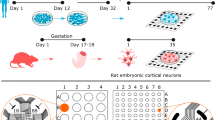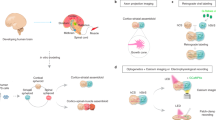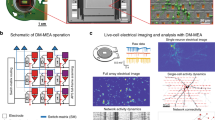Abstract
Micro-island cultures provide a simplified system for studying the expression of cellular phenotype, excitability, synapse formation and pre- and postsynaptic regulatory mechanisms without the usual problems that arise from complex interactions between large numbers of other cells. The technique relies on the ability to constrain the attachment and growth of either single or small groups of neurons to discrete (20–500 μm) 'islands' of cell-permissive substrate applied over a nonadherent background layer. Constrained in this way, neurons form large numbers of conventional synaptic and/or autaptic contacts that can be easily visualized, making them ideally suited for studying synaptic physiology using electrophysiological and/or high-resolution optical imaging techniques. The protocol described here requires approximately 2 h for preparation of the culture dishes and a further 3–4 h for isolation and plating out the cells. Once established, the cultures can be maintained for prolonged periods (>6 weeks) permitting manipulations to be made to their local environment and the effects on individually identified cells to be repeatedly monitored.
This is a preview of subscription content, access via your institution
Access options
Subscribe to this journal
Receive 12 print issues and online access
$259.00 per year
only $21.58 per issue
Buy this article
- Purchase on Springer Link
- Instant access to full article PDF
Prices may be subject to local taxes which are calculated during checkout


Similar content being viewed by others
References
Furshpan, E.J., MacLeish, P.R., O'Lague, P.H. & Potter, D.D. Chemical transmission between rat sympathetic neurons and cardiac myocytes developing in microcultures: evidence for cholinergic, adrenergic, and dual-function neurons. Proc. Natl. Acad. Sci. USA 73, 4225–4229 (1976).
Bourque, M.J. & Trudeau, L.E. GDNF enhances the synaptic efficacy of dopaminergic neurons in culture. Eur. J. Neurosci. 12, 3172–3180 (2000).
Tarsa, L. & Goda, Y. Synaptophysin regulates activity-dependent synapse formation in cultured hippocampal neurons. Proc. Natl. Acad. Sci. USA 99, 1012–1016 (2002).
Schluter, O.M., Basu, J., Sudhof, T.C. & Rosenmund, C. Rab3 superprimes synaptic vesicles for release: implications for short-term synaptic plasticity. J. Neurosci. 26, 1239–1246 (2006).
Furshpan, E.J. Seizure-like activity in cell culture. Epilepsy Res. 10, 24–32 (1991).
Segal, M.M. Epileptiform activity in microcultures containing one excitatory hippocampal neuron. J. Neurophysiol. 65, 761–770 (1991).
Segal, M.M. Endogenous bursts underlie seizurelike activity in solitary excitatory hippocampal neurons in microcultures. J. Neurophysiol. 72, 1874–1884 (1994).
Raman, I.M., Tong, G. & Jahr, C.E. Beta-adrenergic regulation of synaptic NMDA receptors by cAMP-dependent protein kinase. Neuron 16, 415–421 (1996).
Boehm, S. & Betz, H. Somatostatin inhibits excitatory transmission at rat hippocampal synapses via presynaptic receptors. J. Neurosci. 17, 4066–4075 (1997).
Boehm, S. Presynaptic alpha2-adrenoceptors control excitatory, but not inhibitory, transmission at rat hippocampal synapses. J. Physiol. 519, 439–449 (1999).
Brody, D.L. & Yue, D.T. Release-independent short-term synaptic depression in cultured hippocampal neurons. J. Neurosci. 20, 2480–2494 (2000).
Tong, G., Malenka, R.C. & Nicoll, R.A. Long-term potentiation in cultures of single hippocampal granule cells: a presynaptic form of plasticity. Neuron 16, 1147–1157 (1996).
Goda, Y. & Stevens, C.F. Readily releasable pool size changes associated with long term depression. Proc. Natl. Acad. Sci. USA 95, 1283–1288 (1998).
Gomperts, S.N., Rao, A., Craig, A.M., Malenka, R.C. & Nicoll, R.A. Postsynaptically silent synapses in single neuron cultures. Neuron 21, 1443–1451 (1998).
Kimura, F., Otsu, Y. & Tsumoto, T. Presynaptically silent synapses: spontaneously active terminals without stimulus-evoked release demonstrated in cortical autapses. J. Neurophysiol. 77, 2805–2815 (1997).
Sulzer, D. et al. Dopamine neurons make glutamatergic synapses in vitro. J. Neurosci. 18, 4588–4602 (1998).
Johnson, M.D. Synaptic glutamate release by postnatal rat serotonergic neurons in microculture. Neuron 12, 433–442 (1994).
Allen, T.G., Abogadie, F.C. & Brown, D.A. Simultaneous release of glutamate and acetylcholine from single magnocellular “cholinergic” basal forebrain neurons. J. Neurosci. 26, 1588–1595 (2006).
Joyce, M.P. & Rayport, S. Mesoaccumbens dopamine neuron synapses reconstructed in vitro are glutamatergic. Neuroscience 99, 445–456 (2000).
Kimura, F. & Baughman, R.W. Distinct muscarinic receptor subtypes suppress excitatory and inhibitory synaptic responses in cortical neurons. J. Neurophysiol. 77, 709–716 (1997).
Bekkers, J.M. & Stevens, C.F. Excitatory and inhibitory autaptic currents in isolated hippocampal neurons maintained in cell culture. Proc. Natl. Acad. Sci. USA 88, 7834–7838 (1991).
Mennerick, S., Que, J., Benz, A. & Zorumski, C.F. Passive and synaptic properties of hippocampal neurons grown in microcultures and in mass cultures. J. Neurophysiol. 73, 320–332 (1995).
Ullian, E.M., Christopherson, K.S. & Barres, B.A. Role for glia in synaptogenesis. Glia 47, 209–216 (2004).
Brewer, G.J., Torricelli, J.R., Evege, E.K. & Price, P.J. Optimized survival of hippocampal neurons in B27-supplemented Neurobasal, a new serum-free medium combination. J. Neurosci. Res. 35, 567–576 (1993).
Brewer, G.J. Serum-free B27/neurobasal medium supports differentiated growth of neurons from the striatum, substantia nigra, septum, cerebral cortex, cerebellum, and dentate gyrus. J. Neurosci. Res. 42, 674–683 (1995).
Segal, M.M., Baughman, R.W., Jones, K.A. & Huettner, J.E. Mass cultures and microislands of neurons from postnatal rat brain. in Culturing Nerve Cells 2nd edn. (eds. Banker, G. & Goslin, K.) 309–338 (MIT, Cambridge, Massachusetts).
Wainer, B.H. & Mesulam, M.-M. Ascending cholinergic pathways in the rat brain. in Brain Cholinergic Systems (eds. Steriade, M. & Biesold, D.) 65–119 (Oxford University Press, New York, USA).
Segal, M.M. & Furshpan, E.J. Epileptiform activity in microcultures containing small numbers of hippocampal neurons. J. Neurophysiol. 64, 1390–1399 (1990).
Huettner, J.E. & Baughman, R.W. The pharmacology of synapses formed by identified corticocollicular neurons in primary cultures of rat visual cortex. J. Neurosci. 8, 160–175 (1998).
Chen, G. & van den Pol, A.N. Multiple NPY receptors coexist in pre- and postsynaptic sites: inhibition of GABA release in isolated self-inervating SCN neurons. J. Neurosci. 16, 7711–7724 (1996).
Radcliffe, k.A. & Dani, J.A. Nicotinic stimulation produces multiple forms of increased glutamatergic synaptic transmission. J. Neurosci. 18, 7075–7083 (1998).
Pyott, S.J. & Rosenmund, C. The effects of temperature on vesicular supply and release in autaptic cultures of rat and mouse hippocampal neurons. J. Physiol. 539, 523–535 (2002).
Nagler, K., Mauch, D.H. & Pfrieger, F.W. Glia-derived signals induce synapse formation in neurones of the rat central nervous system. J. Physiol. 533, 665–679 (2001).
Acknowledgements
This work was supported by Grant PG7909913 from the UK Medical Research Council.
Author information
Authors and Affiliations
Corresponding author
Ethics declarations
Competing interests
The author declares no competing financial interests.
Rights and permissions
About this article
Cite this article
Allen, T. Preparation and maintenance of single-cell micro-island cultures of basal forebrain neurons. Nat Protoc 1, 2543–2550 (2006). https://doi.org/10.1038/nprot.2006.394
Published:
Issue Date:
DOI: https://doi.org/10.1038/nprot.2006.394
This article is cited by
-
Micropatterned substrates coated with neuronal adhesion molecules for high-content study of synapse formation
Nature Communications (2013)
Comments
By submitting a comment you agree to abide by our Terms and Community Guidelines. If you find something abusive or that does not comply with our terms or guidelines please flag it as inappropriate.



